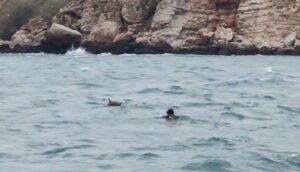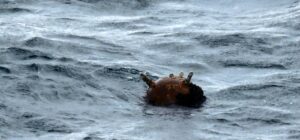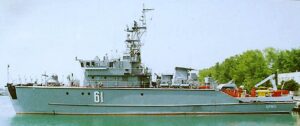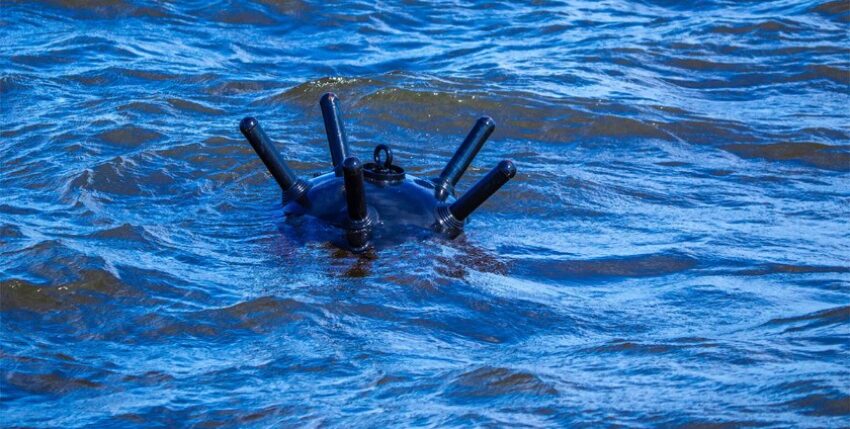Update 25 January 2023
The Bulgarian Navy has in the first two days of this week 23/24/01/2023 two drifting anchor bridges can be rendered harmless. On Monday, a mine-like object was reported floating in the water about 10 miles south of the border with Romania and only 200 metres from the coastal rocks. A helicopter crew was able to verify the mine and direct a speedboat manned by mine divers to the site. The object was identified as a detached Russian-made YaM anchor mine and was defused by an explosive charge five hours after the sighting.

At around the same time, 60 miles to the south, a Ukrainian freighter reported another drifting mine. Confirmed by helicopter sightings, the "Priboy" minesweeper of the "Briz" class (Sonya, project 12650) was directed to the site. However, the heavily overgrown mine of the same YaM design could only be blown up the next morning.

Since the beginning of the war in Ukraine, the Ukrainian, Romanian, Bulgarian and Turkish navies have been able to destroy around 40 floating mines. The fact that civilian shipping has so far not been affected by these mines and that they have not yet led to any losses is generally attributed to increased vigilance and the stricter rules for optical lookouts in the Black Sea.

For all their danger - these mines do not look freshly laid! They may well be anchor mines that were deployed several years ago and have now come loose from their rusting anchors in the winter weather. The Black Sea remains a hot spot!
Source: Maritime Executive
Original contribution
09/09/2022 - What was that again about sea mines in the Black Sea?
We asked ourselves this question - and not lightly - in the editorial office. In short, there seems to be a disparity between the reports of naval mines in the Black Sea and the actual, practical response to them.
Classification: With the Russian invasion of Ukraine on 24 February 2022, which is essentially a land war but has strategic maritime significance for Russia, Ukraine and the global community, the Black Sea part of the conflict from the very beginning. The issue was made public back in April and the danger posed by sea mines to shipping in general and Ukrainian grain shipments in particular was highlighted.
Incidentally, there are no drifting mines that are deliberately laid to drift driftlessly at sea. If such a mine is encountered, it is usually a loose anchor mine.
And since then? Actual damage to or loss of shipping space due to sea mines in the Black Sea are not known to us to date. When the first merchant ships loaded with grain left the Ukrainian harbours, with increased media attention, it was noticed that they were travelling on normal courses, meaning that the shipping lane was clear. This could be traced via the publicly available data from the Automatic Identification Systems (AIS) on board the ships, for example on www.marinetraffic.com. However, nothing else is known about extensive mine clearance operations that must have taken place beforehand.
Lest we misunderstand each other, the danger posed by sea mines is real, even in the Black Sea, and it is quite likely that they were used. However, the picture of the dramatic situation, as presented publicly by the media and the warring parties, contradicts a genuine, deliberate and comprehensive use of sea mines, as this would inevitably produce casualties and would not be as quick and easy to resolve as the impression has been given.
In other words, the development and supposed solution to the challenge of sea mines in the Black Sea less complex than a credible use of these weapons would allow. It is quite possible that both warring parties do not have the capability and expertise to use these weapons, but loudly say otherwise and emphasise this with real and alleged evidence. Incidentally, the question must be asked as to which captain of a merchant ship or the shipping company behind it would take on the responsibility of allowing their own ship to sail through an active minefield under convoy - not only the insurance company sends its regards.
What about the sea mines in the Black Sea? We don't know - but it is quite possible that the truth lies somewhere in the middle between the information fog of war, propaganda on both sides and the complexity of things. Both sides in this war have an interest in emphasising the importance of sea mines for various military and political reasons.
We will continue to monitor the situation and report if there is any news.
Blog #meerverstehen
04.04.2022 - Drift mines in the Black Sea
Turkey and Romania defuse mines: Turkey and Romania have begun joint efforts to search for mines, as there are concerns that floating mines could drift from the Ukrainian coast across the Black Sea towards neighbouring countries.
The mine that surfaced on Monday was the second to be found in the waters off Turkey in three days. The Turkish government had previously stated that it was in contact with both Moscow and Kiev over the weapons, but did not specify which side, if either, was responsible for the mines. Last week, Bulgaria's government warned the residents of three districts on the Black Sea coast from possible floating mines, as reported by local media.
The Russian secret service FSB claimed on 19 March that more than 400 sea mines had become detached from the cables to which they were anchored due to bad weather and warned that the mines were "loose in the western part of the Black Sea", which includes the territorial waters of Ukraine, Romania, Bulgaria and Turkey. Ukraine rejected the claim at the time as untrue and politically motivated. The Ukrainian portal BlackSeaNews also cited the Russian warning about drifting sea mines, claiming that the Russian Black Sea Fleet laid the sea mines on the route between Odessa and the Bosporus. This is not verifiable.
An international treaty from 1907 prohibits countries from letting mines drift. Mines must be designed in such a way that they are rendered harmless no later than one hour after they can no longer be controlled. Most mines, which are known as floating mines, are anchored mines that have been torn loose. A blocking mechanism is built into them, which prevents them from detonating when they float up. Romanian sources report the discovery of a mine 39 nautical miles off the harbour of Midia in south-eastern Romania. It is not known where the mine came from. The Turks have also neutralised a mine off the coast of Igneada, a town in the north-west of the country near the border with Bulgaria (marineforum reported).
Source: Washington Post, ntv, THB











3 responses
Hello and thanks for the great article. Are there any more finds or a portal that publishes finds?
Thank you very much
Kind regards
The water hiker
The International Maritime Organisation (IMO) regularly reports on the security situation in the Black Sea (https://www.imo.org/en/MediaCentre/HotTopics/Pages/MaritimeSecurityandSafetyintheBlackSeaandSeaofAzov.aspx). The last report on the mine location is dated 24 May 2022 (https://wwwcdn.imo.org/localresources/en/MediaCentre/HotTopics/Documents/Ukraine%20crisis%20CL%204524/Circular%20Letter%20No.4573%20-%20Maritime%20Security%20Threat%20Posed%20By%20Free%20Floating%20Sea%20Mines%20In%20TheBlack%20Sea%20Region%20(Secretariat).pdf). Obviously there has been no new situation since then.
Thank you for your well-founded assessment. However, this is - once again - hardly read by media representatives or politicians. Shipping companies are not asked anyway.